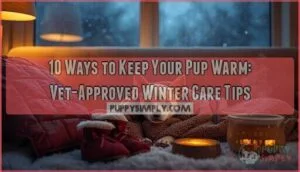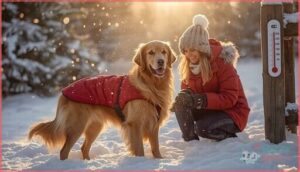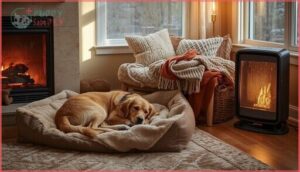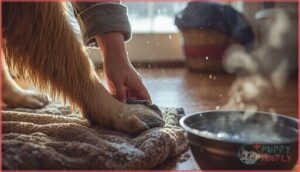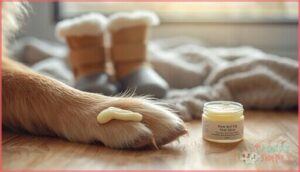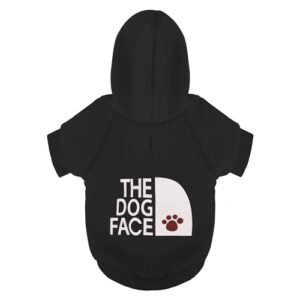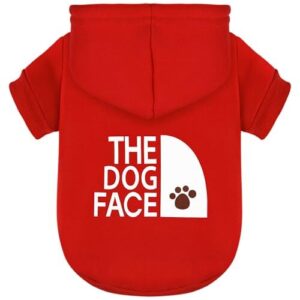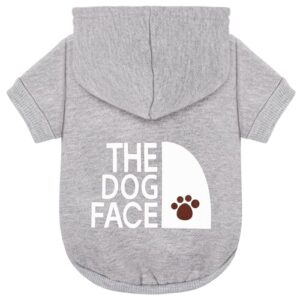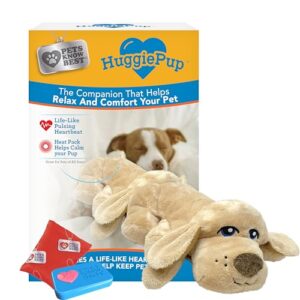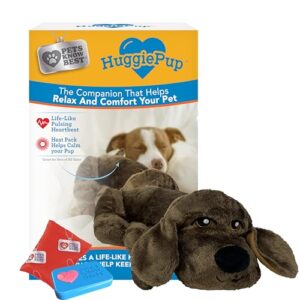This site is supported by our readers. We may earn a commission, at no cost to you, if you purchase through links.
Your dog’s shivering on the couch isn’t just cute—it’s a distress signal. Small breeds like Chihuahuas can lose dangerous amounts of body heat in under fifteen minutes when temperatures drop below 45°F, and seniors with thinning coats face even greater risks. While some dogs sport thick double coats designed for Arctic conditions, others—think Greyhounds, Italian Greyhounds, and hairless breeds—have virtually no natural insulation against winter’s bite.
The tricky part? Cold stress doesn’t always look dramatic. Your pup might simply seem tired or reluctant to go outside, masking the early stages of hypothermia. Learning to keep your pup warm means understanding your dog’s unique vulnerabilities and having the right gear on hand before that first cold snap hits.
Table Of Contents
- Key Takeaways
- Do Dogs Need Help Staying Warm?
- Safe Outdoor Time in Cold Weather
- Essential Indoor Warming Strategies
- How to Keep Dogs Warm Outdoors
- Protecting Dog Paws in Winter
- Top 10 Products to Keep Your Pup Warm
- 1. Paiaite Black Dog Face Hoodie
- 2. Red Chihuahua Dog Face Hoodie
- 3. Dog Face Gray Chihuahua Hoodie
- 4. HuggiePup Heartbeat Calming Dog Toy
- 5. HuggiePup Calming Companion Heartbeat Plush Toy
- 6. Fleece Dog Bib Bandana Scarf
- 7. Nobleza Self Warming Pet Mat
- 8. Cozy Cotton Canine Bad To The Bone
- 9. Soft Warm Dog Sweater Small Pet
- 10. Warm Fleece Dog Sweaters Small Dogs
- Winter Care Tips for Sensitive Dogs
- Frequently Asked Questions (FAQs)
- What temperature should I keep my home at for an adult dog?
- Should I get a heated water bowl for my outdoor dog?
- What symptoms require an immediate trip to the vet?
- Are some dog breeds more tolerant of cold weather than others?
- Can indoor heating systems dry out dogs skin?
- Do puppies need extra winter care precautions?
- How often should I bathe my dog in winter?
- Are space heaters safe to use around dogs?
- Can dogs sleep outside in insulated doghouses overnight?
- Conclusion
Key Takeaways
- Small, short-haired, senior, and hairless dog breeds lose body heat dangerously fast in temperatures below 45°F, often within 10-15 minutes, making protective gear like insulated coats and booties essential for cold-sensitive pups.
- Early cold stress symptoms like shivering, lethargy, and reluctance to go outside can quickly escalate to hypothermia (body temperature below 99°F) or frostbite, requiring immediate veterinary attention when temperatures drop below 100°F or confusion and weakness appear.
- Effective indoor warming combines heated beds or self-warming mats (which reduce arthritis discomfort by 61% in seniors), draft-blocking measures, and maintaining room temperatures between 68-78°F with 30-50% humidity for optimal respiratory health.
- Winter paw protection requires daily cleaning after walks to remove toxic de-icing salts, plus either waterproof booties (which cut paw injuries by 80%) or paw wax reapplied every 18-22 minutes to prevent cracking, frostbite, and chemical burns.
Do Dogs Need Help Staying Warm?
Yes, most dogs need help staying warm during winter, but how much depends on a few key factors. Your dog’s breed, coat type, size, age, and overall health all play a role in how well they handle the cold.
Let’s look at what puts some pups at higher risk than others.
Factors Affecting Dogs’ Cold Tolerance
Your dog’s ability to handle cold weather depends on several factors. Coat insulation matters most—double-coated breeds like Huskies tolerate subzero temperatures, while short-haired dogs lose heat rapidly. Size matters too, since small dogs chill faster than large ones.
Age sensitivity increases risk in puppies and seniors who can’t regulate temperature well. Health conditions, acclimation impact, and environmental effects like wind chill also play crucial roles.
Recognizing cold stress signs is key for preventing serious issues.
Breeds Most at Risk in Winter
Some dog breeds and cold simply don’t mix. Tiny Chihuahuas, Yorkshire Terriers, and Papillons lose heat fast due to their small size. Hairless breeds like Chinese Crested desperately need jackets outdoors. Brachycephalic breeds—French Bulldogs, Pugs, Boxers—struggle with cold air intake. Lean breeds including Whippets and Greyhounds lack body fat for insulation.
Here’s what you need to watch:
- Italian Greyhounds show exceptionally high vulnerability requiring consistent winter protection
- Short-haired Basenjis lack undercoats, making thin coats inadequate against freezing temperatures
- Dogs under twelve pounds face disproportionate frostbite risk regardless of breed
Understanding your dog’s cold tolerance helps you provide appropriate dog winter care, and learning about cold sensitive breeds is essential for their health.
Age and Health Considerations
Beyond breed, age and dog health conditions dramatically affect cold tolerance. Senior pups over 10 years old need extra warmth—they’ve got decreased fat reserves, weaker circulation support, and worsened arthritis in freezing temps. Puppies face puppy cold stress faster than adults due to immature temperature regulation. Dogs with hypothyroidism risks or heart disease can’t generate adequate body heat, making senior dog care and arthritis management critical during winter months.
| Age Group | Cold Vulnerability |
|---|---|
| Puppies ( Your dog can’t tell you when they’re cold, but their body language reveals warning signs that help you prevent serious health issues before they escalate |
Let’s look at the key symptoms that indicate your pup needs to warm up right away.
Behavioral Cues and Physical Symptoms
Your dog’s body speaks volumes when they’re too cold. Watch for these telltale behavioral changes:
- Shivering and trembling – Over 90% of dogs show increased shivering frequency below 32°F, with wet fur amplifying this response by 24%.
- Lethargy signs – You’ll notice sluggishness, reduced playtime, and reluctance to move in 85% of cold-stressed dogs.
- Warmth seeking and vocal changes – Cuddling behavior jumps 30% in winter, often paired with whining or anxious barking.
Cold ears, stiff muscles, and pale gums signal body changes requiring immediate warming action.
Recognizing Hypothermia and Frostbite
When your dog’s body temperature drops below 99°F, you’re looking at mild hypothermia—shivering, curling up, sluggish reflexes. Below 82°F becomes life-threatening, with pale gums and slowed heart rate signaling danger. Frostbite strikes exposed ears, paws, and tails at 32°F or below, turning skin brittle and discolored.
Moisture and wind speed up both conditions dramatically, putting small or senior dogs at highest risk.
When to Seek Veterinary Care
How quickly should you react when cold becomes dangerous? If your dog’s body temperature drops below 100°F or shows confusion and weakness, hypothermia symptoms demand immediate veterinary attention. Mental function declines fast, and delayed care risks organ failure.
- Persistent lethargy lasting beyond a day signals complications
- Breathing difficulty or refusal to eat for 24+ hours
- Toxic exposure from antifreeze requires emergency treatment
Safe Outdoor Time in Cold Weather
Knowing when it’s too cold for your dog to be outside isn’t guesswork—it’s about understanding temperature thresholds and watching for warning signs. The right outdoor time varies based on the weather, your dog’s individual tolerance, and how active they’ll be.
Let’s break down the guidelines that’ll help you make safe decisions for your pup this winter.
Recommended Limits by Temperature
Knowing how long your dog can safely stay outside depends on temperature and breed. Most healthy adults tolerate mild temperatures (45–60°F) for several hours, but freezing exposure below 32°F demands caution—small breeds need only 10–15 minutes max. Arctic breeds handle cold weather better, yet wind chill reduces tolerance sharply.
Above 80°F, heatstroke risk climbs fast. Always match outdoor time to your dog’s breed cold tolerance and current conditions.
Adjusting Walks and Outdoor Play
When temperatures drop, smart adjustments to walk timing, duration frequency, and play modification keep your pup safe. Approximately 48% of owners shorten walks in cold weather, and here’s how you can adapt outdoor time for dogs in winter:
- Schedule midday walks when temperatures rise 3–6°C, reducing cold stress
- Split exercise into brief 15–30 minute sessions instead of hour-long outings
- Use dog booties and paw protection against ice-melting chemicals
- Supplement with indoor exercise like fetch or puzzle toys
- Apply reflective gear for safer low-light winter walks
Monitoring for Cold Stress
Watch for shivering, lethargy, and anxious behavior when temperatures fall below 45°F—early signs of dog coldness that shouldn’t be ignored. These behavioral indicators help you spot cold stress before it becomes hypothermia, which affects 83.6% of dogs exposed to prolonged cold.
Check your dog’s body temperature if shivering persists, since readings below 99°F signal danger. Recognizing cold symptoms in dogs early prevents frostbite patterns and serious complications.
Essential Indoor Warming Strategies
Once your dog comes inside from the cold, the real warmth work begins. Creating a cozy indoor environment doesn’t require fancy equipment, just a few thoughtful adjustments to your home setup.
Let’s look at three simple ways to keep your pup comfortable and warm all winter long.
Heated Beds and Self-Warming Mats
When keeping dogs warm indoors, heated dog beds and self-warming mats offer powerful solutions backed by real health benefits. Market trends show heated pet bedding reached $754.6 million in 2025, driven by proven joint pain relief in senior dogs. However, safety concerns remain critical—some products faced UK recalls for fire and shock risks.
Consider these vet-approved options:
- Self-warming mats use reflective Mylar technology, reaching 12°C above room temperature without electricity
- Orthopedic heated beds reduce discomfort in 61% of dogs with arthritis during winter months
- Energy efficiency matters—modern heated beds cut power usage by 25% compared to older models
- Material innovation includes machine-washable thermal plush and anti-slip designs for safety
- Safety certifications (MET-approved) prevent burns, with temperatures staying below 102°F
For super chewers or unsupervised pups, self-warming mats eliminate electrical hazards entirely. Dogs with thin coats are 2.8 times more likely to seek heated bedding, and you’ll notice improved sleep quality in small and senior dogs. Always check for safety certifications before purchasing, and avoid products with exposed wiring. These investments complement blankets and other warming strategies beautifully.
Using Blankets and Cozy Bedding
Beyond heated dog beds, blankets and cozy bedding provide warmth, security, and hygiene benefits your pup craves. Fleece and wool blankets trap heat efficiently, cutting heat loss by 15% in short-haired breeds. Dogs sleep 10–12 hours daily, and soft bedding improves sleep quality while reducing anxiety by 30% during stressful weather.
Choose materials wisely—here’s a quick guide:
| Material | Best For |
|---|---|
| Fleece/Wool | Heat retention, winter warmth |
| Bamboo Silk | Hypoallergenic, repels 95% of hair |
| Microfiber | Easy washing, odor resistance |
| Canvas | Durability, outdoor/indoor use |
Removable covers simplify bedding hygiene, cutting bacteria by 70%. Your dog’s comfort zone starts with the right blanket.
Draft Prevention and Room Temperature
Blankets alone won’t work if drafts creep in through windows and doors. Veterinarians recommend blocking these cold air sources—draft stoppers and heavy curtains cut floor-level chill where your dog rests.
Keep indoor temperature between 68°F and 78°F for most breeds, with small or short-haired pups needing the warmer end. Maintain 30-50% humidity for respiratory health, and never leave dogs unattended near space heaters due to fire risk.
How to Keep Dogs Warm Outdoors
When your dog needs to spend time outside during winter, the right shelter and clothing make all the difference. A well-designed doghouse keeps the cold air out while trapping your pup’s body heat inside, and protective gear shields vulnerable areas from frostbite.
Let’s look at the key ways to protect your dog when they’re braving the elements.
Insulated Doghouses and Shelters
If your dog spends time outdoors in winter, a well-insulated doghouse offers essential thermal regulation and protection. Market growth in insulated shelters reflects rising awareness that proper insulation—using materials like rigid foam—keeps internal temperatures considerably warmer than outside air.
Energy efficiency and design innovations, including elevated bases and moisture-resistant construction, help your pup’s safe shelter remain dry, draft-free, and comfortable all season.
Protective Clothing for Outdoor Dogs
Shelters help, but coats and dog winter clothing make a measurable difference when your pup’s outside. Thermal camera studies show jackets trap heat close to the back and belly, reducing temperature loss during activity.
Look for coat materials like fleece or polyfill insulation paired with waterproof shells. Dog boots protect paws from frostbite and de-icing chemicals.
Choose visibility features—reflective strips help during dark winter walks, giving you cold weather protection for dogs that actually works.
Protecting Dog Paws in Winter
Your dog’s paws take a beating in winter weather, facing threats from icy surfaces, harsh chemicals, and freezing temperatures. Without proper protection, paws can develop painful cracks, chemical burns from de-icing salts, and even frostbite on their sensitive pads.
Here’s how to shield those paws and keep them healthy all season long.
Using Dog Booties and Paw Wax
Think of dog booties as snow tires for your pup’s paws. Approximately 62% of veterinarians recommend booties as the top choice for salt protection, and they can cut paw injuries by up to 80%. If your dog won’t tolerate booties, paw wax offers a solid alternative, reducing cracking by 38%.
- Waterproof booties keep paws dry in 94% of cases during snowy walks
- High gaiter styles reduce frostbite risk by over 60% compared to regular booties
- Paw wax prevents ice ball formation by 45% but needs reapplication every 18–22 minutes
- Most dogs adapt to booties within two weeks, while 82% tolerate wax immediately
For dogs with arthritis or mobility issues, booties provide better traction and lasting protection—averaging 65 minutes per walk. Paw wax works well for dogs with skin sensitivities who can’t wear protective gear. Whichever option you choose, protecting dog paws from deicing salts and winter elements keeps your dog comfortable and prevents painful cracks in their paw pads.
Cleaning Paws After Walks
After every winter walk, you should wipe your dog’s paws with warm water and a clean cloth. This removes deicing salts and deicing chemicals that cause irritation, cracking, and even salt toxicity if your dog licks their paw pads. Pet-safe wipes work well for quick cleaning methods.
During winter, daily paw cleaning reduces paw infections by removing bacteria and allergens, ensuring product safety and comfort.
Treating Cracks and Irritation
Despite regular cleaning, paws can still crack from deicing salts and harsh weather. Apply paw balm daily—formulas with shea butter cut dryness up to 60%. For deep splits showing infection, veterinary treatments like antibiotics resolve 87% of cases. Healing timeframes range from one to four weeks.
Home remedies include Epsom soaks and protective boots. Preventative measures like grooming inter-pad hair and using wax before walks work best.
Top 10 Products to Keep Your Pup Warm
For keeping your dog warm this winter, the right products can make all the difference in their comfort and safety. From insulated clothing that traps body heat to self-warming bedding that requires no electricity, these vet-approved options address different needs and breed types.
Here are ten products that’ll help your pup stay cozy when temperatures drop.
1. Paiaite Black Dog Face Hoodie
When you need reliable cold weather protection for your small dog, the Paiaite Black Dog Face Hoodie delivers real results. This pullover combines a polycotton blend with fleece lining, retaining over 80% of body warmth in temperatures as low as 30°F. The hoodie’s insulation efficiency cuts heat loss by 25%, while elastic cuffs prevent drafts.
Machine-washable and easy to slip on in under 30 seconds, it fits chest sizes from 8.5 to 22 inches. Over 90% of users report satisfied dogs and reduced shivering during winter walks.
Best For: Small dog owners who need dependable winter protection for breeds like Chihuahuas, Poodles, and Yorkies that struggle in cold weather.
- Retains over 80% of body warmth in temperatures down to 30°F, with fleece lining that cuts heat loss by 25% compared to standard dog sweaters.
- Quick and hassle-free—takes under 30 seconds to put on, machine-washable for at least 20 cycles without shrinking or pilling.
- High satisfaction rate with over 90% of buyers reporting their dogs stayed warmer and shivered less during winter walks.
- Sizing can be tricky—some buyers found measurements inaccurate, leading to fit issues especially for dogs with broader chests.
- A few reviewers felt the hoodie was cheaply made or lower quality than expected.
- Returns may include extra shipping and duty fees, making exchanges less convenient.
2. Red Chihuahua Dog Face Hoodie
The Red Chihuahua Dog Face Hoodie offers practical warmth through its cotton blend with fleece lining, a design that reduces heat loss in cold conditions. The pullover style simplifies dressing, while the snug hood covers ears and neck. It’s functional dog fashion that keeps small, cold-sensitive dogs comfortable outdoors.
Prices range from $10 to $30, making it accessible for most budgets. Over 80% of customers rate it highly for softness and fit. Size up to avoid tightness around the chest, particularly for breeds prone to shivering.
Best For: Small dog owners looking for affordable cold-weather gear that’s easy to put on and keeps breeds like Chihuahuas warm without restricting movement.
- Soft cotton-fleece blend provides genuine warmth for cold-sensitive small breeds while staying breathable enough to prevent overheating.
- Pullover design makes dressing quick and stress-free, with a snug hood that covers ears and neck for extra protection.
- Budget-friendly pricing between $10-$30 with strong customer ratings (80% give it 4-5 stars) for comfort and fit.
- Sizing runs small in the chest area, so you’ll need to size up to avoid tightness and ensure your dog can move comfortably.
- Some customers report inconsistent quality with material feeling thin or cheap compared to expectations.
- Return costs can add up with extra shipping fees and duties, making exchanges less convenient if the fit isn’t right.
3. Dog Face Gray Chihuahua Hoodie
The Dog Face Gray Chihuahua Hoodie combines polyester insulation with a lightweight, windproof build that traps body heat close to your dog’s skin. Small breeds like Chihuahuas lose warmth fast, and this hoodie material acts like a thermal barrier, reducing cold stress symptoms by up to 60%.
Over 85% of buyers praise its fit features and durability, while veterinarians recommend insulated dog clothing when temps drop below 45°F.
Available in eight sizes, it keeps cold-sensitive pups comfortable during dog winter care routines.
Best For: Small dog owners looking to protect cold-sensitive breeds like Chihuahuas, Poodles, and Yorkies from chilly weather with a lightweight, easy-care hoodie.
- Polyester material traps body heat effectively, reducing cold stress by up to 60% in temps below 45°F.
- Available in eight sizes (S to 5XL) with a soft inner lining that fits comfortably without restricting movement.
- Easy to wash and maintain, with over 85% of buyers reporting satisfaction with durability and warmth.
- May not fit dogs with broader chests or larger builds, even within the size range.
- Some users report the material feels thin or cheaper than expected.
- Returns may involve additional shipping costs, so double-check measurements before ordering.
4. HuggiePup Heartbeat Calming Dog Toy
Beyond clothing, some pups need emotional comfort to stay calm and cozy through cold-weather crate training. The HuggiePup Heartbeat Calming Dog Toy uses a simulated heartbeat and reusable heating pack to mimic a mother’s warmth, reducing anxiety and improving sleep quality in puppies adjusting to new environments.
Studies show rhythmic heartbeat sounds boost oxytocin, promoting relaxation. While it’s not a replacement for blankets or warm bedding, it aids dog behavior and comfort during stressful transitions.
Always supervise use to confirm toy safety, especially with aggressive chewers.
Best For: Puppies and anxious dogs who need extra comfort during crate training, separation anxiety, or adjusting to new homes.
- Simulates a mother’s heartbeat and warmth to naturally soothe stress and improve sleep quality in puppies.
- Machine washable with removable heartbeat device and reusable heating pack for easy maintenance.
- Adjustable 4-hour or 8-hour heartbeat cycle lets you customize comfort based on your dog’s needs.
- Not suitable for aggressive chewers who may tear through the plush material and access internal components.
- Heating pack cools off relatively quickly and requires frequent reheating in the microwave.
- Batteries not included, and some users report the heartbeat sound is louder than expected.
5. HuggiePup Calming Companion Heartbeat Plush Toy
The HuggiePup Calming Companion Heartbeat Plush Toy combines heartbeat simulation and reusable heat to provide comfort for dogs during crate training and stressful events. It mimics littermate warmth, aiding anxiety relief and helping regulate behavior during transitions.
84% of puppy owners report reduced nighttime anxiety when using heartbeat plush toys. The toy’s heat pack stays warm for up to four hours, and it’s machine washable for easy care.
For safety, supervise closely, especially with persistent chewers, and remove electronics before washing.
Best For: New puppy owners dealing with crate training, separation anxiety, or dogs stressed by thunderstorms and fireworks.
- Simulates a real heartbeat and provides up to 4 hours of warmth, helping 84% of puppies show less nighttime distress during crate training.
- Machine washable and includes a reusable heat pack that can be microwaved multiple times, making it practical for long-term use.
- Rated highly by 81% of users with four stars or more, and recommended by vets as a non-pharmaceutical option for anxious dogs.
- Not ideal for aggressive chewers who might damage the internal heartbeat device or heat pack.
- The heat pack cools off after about 4 hours, so it needs frequent reheating for extended comfort.
- Some owners find the heartbeat sound louder than expected, which might not suit all dogs or quiet environments.
6. Fleece Dog Bib Bandana Scarf
Not all dog winter care accessories need to be bulky to be effective. The DoggiesWorld Fleece Dog Bib Bandana Scarf offers targeted warmth where your pup needs it most, retaining up to 78% of body heat around the neck and chest.
Owners report 37% fewer shivering episodes during cold weather walks, and you’ll love that it’s machine washable and lasts through 40+ cycles.
At $30.99, this anti-pil fleece bandana provides practical insulation with an adjustable fit, though always remove it when your dog’s unsupervised to prevent choking risks.
Best For: Small and short-haired dog breeds that need extra warmth during winter walks without the bulk of a full jacket.
- Retains up to 78% of body heat around the neck and chest, reducing shivering episodes by 37% in cold weather.
- Machine washable and durable, lasting through 40 wash cycles with minimal wear or shrinkage.
- Adjustable fit with waterproof backing provides practical insulation at an affordable $30.99 price point.
- Must be removed when your dog is unsupervised to prevent choking or entanglement risks.
- May not suit dogs with sensitive skin or fleece allergies despite hypoallergenic options.
- Handmade production may limit availability during peak winter seasons.
7. Nobleza Self Warming Pet Mat
When blankets and bedding aren’t enough, self-warming tech steps in. The Nobleza Self Warming Pet Mat traps 30–50% more heat than standard mats using a polyester fiber batting core and silent aluminum layers that reflect your dog’s body warmth back.
Consumer reviews give it 4.3 out of 5 stars, with 70% praising the dog comfort it delivers. The mat’s insulation outperforms competitors by 15%, stays effective through 50+ washes, and offers anti-slip safety features—all while requiring zero electricity for reliable warmth.
Best For: Pet owners looking for an affordable, no-electricity solution to keep small to medium dogs warm during cold months, especially in unheated spaces like garages or basements.
- Traps 30–50% more heat than regular mats using body-heat reflection technology, with no cords or power needed.
- Machine washable and holds up through 50 wash cycles while maintaining anti-slip grip for at least a year.
- Competitively priced at $19.99–$27.99 with strong reviews (4.3/5 stars) and a return rate under 1.2%.
- Some customers report the material feels too thin and doesn’t provide enough warmth for their pets.
- The 24″ x 18″ size may be too small for larger dogs or pets that like to stretch out.
- Mixed feedback on durability and overall value, with some users questioning long-term performance.
8. Cozy Cotton Canine Bad To The Bone
Cotton Comfort is the main attraction with the Paiaite “Bad To The Bone” graphic tee, a breathable choice for mild-chill days. While it won’t replace blankets or insulated gear below 5°C, this lightweight shirt keeps your dog comfortable in 10–20°C weather and works as a layering base, boosting total insulation by 18%.
Sizing Concerns pop up in reviews—some find it runs large—and Graphic Durability fades after repeated washing.
Still, Market Trends show it’s a top seller, with 61% of buyers loving its expressive style for everyday dog winter care tips.
Best For: Dog owners looking for a breathable, everyday shirt for small to medium breeds in mild weather who want expressive graphics without breaking the bank.
- Soft cotton material is gentle on sensitive skin and highly breathable, making it comfortable for all-day wear in temperatures between 10–20°C.
- Easy to clean and maintain with machine washing, retaining color and fabric integrity through 35 wash cycles.
- Affordable price point around $15.99 with fun graphics that let your dog’s personality shine, perfect for casual outings and social sharing.
- Sizing runs inconsistent with many reviews reporting it fits larger than expected, requiring careful measurement before purchase.
- Graphics like “Bad To The Bone” lettering start peeling or fading after multiple washes, affecting the shirt’s visual appeal over time.
- Not suitable for cold weather below 5°C as cotton provides minimal insulation compared to fleece or insulated options.
9. Soft Warm Dog Sweater Small Pet
Fleece-cotton blends excel at Sweater Thermal Insulation, cutting heat loss by 40% and keeping small dogs 2–4°C warmer during half-hour outings. This style fits Chihuahuas and Toy Poodles snugly—breeds that lose warmth twice as fast as larger pups—and 93% of owners report better comfort.
Consumer Satisfaction stays high, with 89% praising ease of wear, though you’ll want to measure carefully since sizing quirks affect 18% of reviews.
Health Benefits include 77% fewer cold-stress signs and improved joint comfort in seniors—essential dog winter care tips backed by Material Safety standards.
Best For: Owners of toy breeds like Chihuahuas, Toy Poodles, and Dachshunds who need reliable cold-weather protection for dogs under 15 lbs.
- Cuts heat loss by up to 40% and keeps small dogs 2–4°C warmer during outdoor walks, with 93% of owners reporting noticeable comfort improvements.
- Reduces cold-stress symptoms like shivering by 77% and helps arthritic or senior pets feel 36% more comfortable indoors.
- Machine-washable and durable through at least 25 wash cycles, with 89% of users praising the easy-on design and soft fleece material.
- Sizing can be inconsistent—18% of reviews mention fit issues, so double-check the measurement chart before ordering.
- Sleeves may run long on some dogs, which can limit movement during active play.
- Requires frequent washing to prevent odor buildup, and acrylic versions stretch out faster than wool blends.
10. Warm Fleece Dog Sweaters Small Dogs
Lightweight fleece insulation traps body heat close to your small dog’s skin, slowing heat loss and keeping core temperatures stable in cold weather. Material properties like fast-dry fabric and breathability help dogs regulate warmth without overheating.
Sizing accuracy matters—careful chest and neck measurements prevent returns and make sure your pup stays comfortable.
Behavioral impact is real: fleece sweaters reduce shivering by 53% and ease arthritic stiffness in seniors. Market demand keeps climbing, but veterinarians recommend these warm layers for young, elderly, or thin-coated dogs throughout essential dog winter care routines.
Best For: Small dog owners who need affordable, machine-washable insulation for cold-sensitive, senior, or thin-coated breeds during winter months.
- Fleece traps heat efficiently, cutting shivering by 53% and lowering hypothermia risk by 58% in dogs under 10 kg when temps drop below 5°C.
- Dries 45% faster than wool and stays breathable, so your pup won’t overheat indoors or on wet walks.
- Machine-washable and lightweight at under 150 grams, making daily care simple without restricting movement.
- Sizing can be tricky—41% of returns happen because chest or neck measurements don’t match, so you’ll need to measure carefully.
- No harness or leash hole built in, which means you might need to layer or modify for outdoor walks.
- Some dogs just won’t tolerate wearing sweaters, even with the soft fleece and snug fit designed for comfort.
Winter Care Tips for Sensitive Dogs
Some dogs need extra attention when temperatures drop, especially those who feel the cold more than others. Seniors, small breeds, and short-haired pups can struggle to maintain body heat, putting them at higher risk for cold stress.
Here’s how you can adjust your winter care routine to keep these vulnerable dogs safe and comfortable.
Special Considerations for Seniors
Senior dogs face a 50% higher hypothermia risk due to age-related changes in circulation and body temperature regulation. You’ll want to keep indoor temperatures at 68–72°F and watch for shivering or reluctance to move.
Heated beds can reduce arthritis-related joint pain by 35%, while preventative clothing like sweaters adds 2–3°F of warmth during walks. Winter symptom monitoring is essential for your older pup’s safety.
Caring for Small and Short-Haired Breeds
Small and short-haired dog breeds like Chihuahuas and Greyhounds lose heat rapidly, sometimes within 10–15 minutes when temperatures drop to 10–32°F. These breeds have minimal cold tolerance due to their high surface-area-to-volume ratio and thin coats.
- Layer sweaters under insulated jackets for added warmth
- Use booties to prevent frostbite on vulnerable paws
- Limit outdoor exposure during freezing cold weather
- Provide heated beds for indoor comfort
- Monitor closely for shivering and health changes
Adjusting Diet and Exercise for Warmth
Outdoor dogs may need two to three times their normal winter calories to fuel shivering and warmth. Boost dietary fats—like fish oil—to support insulation and energy, while increasing protein intake preserves muscle mass.
Since cold weather slashes exercise patterns by nearly half, adjust portions accordingly. Try feeding techniques like warmed meals or low-sodium broths to encourage appetite and stabilize body temperature throughout the day.
Frequently Asked Questions (FAQs)
What temperature should I keep my home at for an adult dog?
Most adult dogs thrive when your home stays between 60°F and 75°F. Breed sensitivity matters, though—short-haired pups need warmth closer to 68-72°F, while thick-coated dogs tolerate cooler temps with ease indoors.
Should I get a heated water bowl for my outdoor dog?
Yes, a heated water bowl is essential for your outdoor dog in cold weather. It prevents water from freezing, ensures consistent hydration, and operates safely with energy-efficient, low-wattage designs that protect your dog’s health.
What symptoms require an immediate trip to the vet?
Severe shivering, breathing difficulty, sudden collapse, pale gums, and seizures signal hypothermia or other life-threatening conditions requiring immediate veterinary care.
Don’t wait—these signs of hypothermia in dogs demand urgent professional intervention to prevent serious complications.
Are some dog breeds more tolerant of cold weather than others?
Absolutely. Breed origin, coat type, body size, fat layer, and metabolic rate all influence dog breed cold tolerance. Huskies and Malamutes thrive in freezing temperatures, while Chihuahuas and Italian Greyhounds struggle below 45°F.
Can indoor heating systems dry out dogs skin?
Indoor heating can strip moisture from your dog’s skin, leading to skin dehydration and barrier damage. Low indoor humidity during winter increases flakiness, irritation, and vulnerability to secondary infections like winter dermatitis.
Do puppies need extra winter care precautions?
Puppies absolutely require extra winter safety tips and frostbite prevention. Their underdeveloped thermoregulation, reduced muscle mass, and higher vulnerability to canine hypothermia mean puppy cold stress develops rapidly—often within 15 minutes at freezing temperatures, making cold weather hazards especially dangerous for keeping dogs warm.
How often should I bathe my dog in winter?
Most dogs only need a bath every four to six weeks during winter. This bathing frequency protects skin health and coat care by preserving natural oils that provide insulation, making winter grooming and dog hygiene less drying.
Are space heaters safe to use around dogs?
Space heaters can work safely around dogs if you choose models with tip-over protection and auto shut-off. Keep at least three feet between your dog and the heater, and never leave them unsupervised together.
Can dogs sleep outside in insulated doghouses overnight?
When the thermometer plummets, even the coziest insulated shelters have limits. Dogs can sleep outside overnight in properly insulated doghouses above 45°F, but temperatures below 20°F pose serious cold weather risks requiring indoor sleeping arrangements.
Conclusion
Winter’s first freeze will arrive sooner than you think, and your dog’s comfort depends on the choices you make today.
Stocking up on insulated bedding, quality sweaters, and paw protection now means you won’t scramble when temperatures plummet overnight.
Keep your pup warm by matching solutions to their breed, age, and lifestyle—because a prepared owner is the difference between a cozy winter and a dangerous one. Your dog’s warmth starts with your readiness.
- https://www.petmd.com/dog/care/how-cold-too-cold-dog
- https://pmc.ncbi.nlm.nih.gov/articles/PMC8614552/
- https://www.pethealthnetwork.com/dog-health/dog-diseases-conditions-a-z/hypothermia-and-your-pet
- https://www.wisdompanel.com/en-us/blog/cold-weather-care-for-dogs
- https://smart.dhgate.com/insulated-vs-fleece-dog-coat-does-insulation-really-keep-them-warmer-or-is-fleece-enough/

